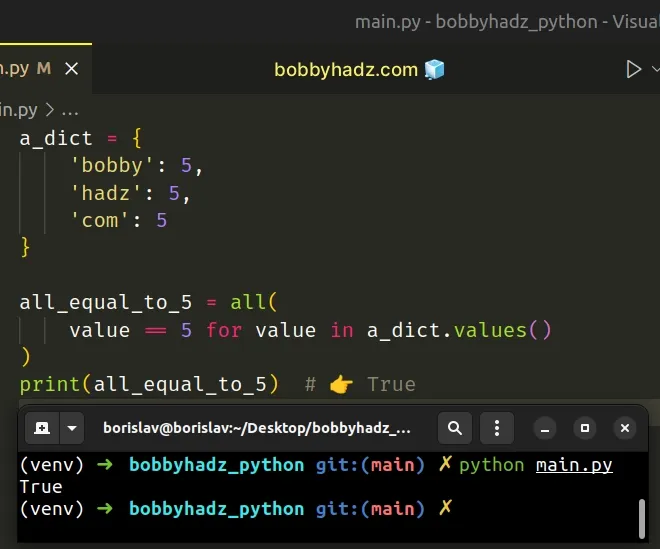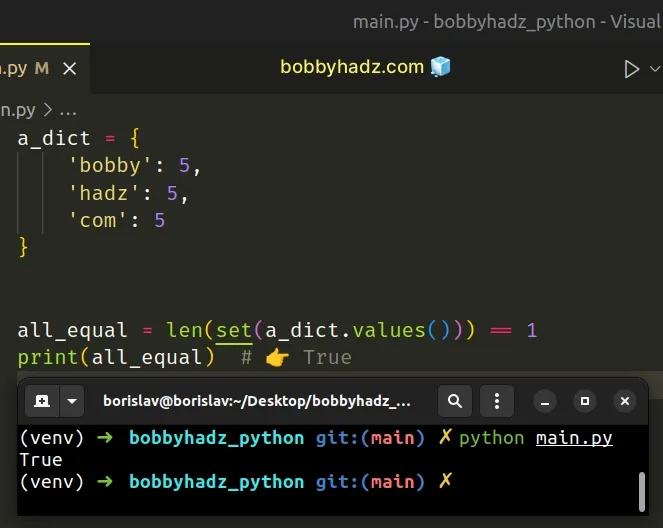Check if all values in a Dictionary are equal in Python
Last updated: Apr 10, 2024
Reading time·5 min

# Table of Contents
- Check if all values in a Dictionary are equal in Python
- Check if all values in a Dictionary are equal using a
set - Check if all values in a Dictionary are equal using
list.count() - Check if all values in a Dictionary are equal using a
forloop
# Check if all values in a Dictionary are equal in Python
To check if all values in a dictionary are equal:
- Use the
dict.values()method to get the first value of the dictionary. - Use the
all()function to iterate over the dictionary's values. - If all other dictionary values are equal to the first value, then the dictionary's values are equal.
a_dict = { 'bobby': 5, 'hadz': 5, 'com': 5 } # ✅ Check if all values in dict are equal to a specific value all_equal_to_5 = all(value == 5 for value in a_dict.values()) print(all_equal_to_5) # 👉️ True # ------------------------------------------------- # ✅ Check if all values in dict are equal first_value = list(a_dict.values())[0] print(first_value) # 👉️ 5 all_equal = all(value == first_value for value in a_dict.values()) print(all_equal) # 👉️ True

The first example checks if all of the values in a dictionary are equal to a specific value.
The second example checks if all of the values in a dictionary are equal.
We used the dict.values() method to get a view of the dictionary's values.
a_dict = { 'bobby': 5, 'hadz': 5, 'com': 5 } # 👇️ dict_values([5, 5, 5]) print(a_dict.values())
The all() built-in function
takes an iterable as an argument and returns True if all elements in the
iterable are truthy (or the iterable is empty).
We passed a
generator expression
to the all() function.
On each iteration, we compare the current dictionary value to the number 5 and
return the result.
a_dict = { 'bobby': 5, 'hadz': 5, 'com': 5 } all_equal_to_5 = all(value == 5 for value in a_dict.values()) print(all_equal_to_5) # 👉️ True if all_equal_to_5: # 👇️ this runs print('All values in the dictionary are equal to the specified value') else: print('Not all values in the dictionary are equal to the specified value')
all() function returns True only if the condition is met for all values in the dictionary.If the condition isn't met at least once, the all() function short-circuits
and returns False.
You can use the same approach if you simply need to check if all of the values in a dictionary are equal.
a_dict = { 'bobby': 5, 'hadz': 5, 'com': 5 } first_value = list(a_dict.values())[0] print(first_value) # 👉️ 5 all_equal = all(value == first_value for value in a_dict.values()) print(all_equal) # 👉️ True
We used the list() class to convert the view of the dictionary's values to a
list to be able to access the first value.
The last step is to compare the first value to all other values in the dictionary.
Alternatively, you can use a set object.
# Check if all values in a Dictionary are equal using a set
This is a three-step process:
- Use the
set()class to convert the dictionary's values to asetobject. - Use the
len()function to get the length of theset. - If the
sethas a length of1, then all values in the dictionary are equal.
a_dict = { 'bobby': 5, 'hadz': 5, 'com': 5 } all_equal = len(set(a_dict.values())) == 1 print(all_equal) # 👉️ True

The set() class takes an
iterable optional argument and returns a new set object with elements taken
from the iterable.
set all duplicates are automatically removed.The last step is to use the len() function to get the length of the set
object and compare the result to 1.
If the set has a length of 1, then all values in the dictionary are equal.
Alternatively, you can use the list.count() method.
# Check if all values in a Dictionary are equal using list.count()
This is a three-step process:
- Use the
dict.values()method to get the first value in the dictionary. - Convert the dictionary's values to a list.
- Use the
list.count()method to check if the occurrences of the first value are equal to the dictionary's length.
a_dict = { 'bobby': 5, 'hadz': 5, 'com': 5 } first_value = list(a_dict.values())[0] all_equal = list(a_dict.values()).count(first_value) == len(a_dict) print(all_equal) # 👉️ True
list() class to convert the dictionary's values to a list to be able to use the list.count() method.The list.count() method takes a value and returns the number of times the
provided value appears in the list.
my_list = [None, None, None] print(my_list.count(None)) # 👉️ 3 print(my_list.count('hello')) # 👉️ 0
If the number of occurrences of the first value in the dictionary is equal to the dictionary's length, then all values in the dictionary are equal.
# Check if all values in a Dictionary are equal using a for loop
This is a four-step process:
- Use the
dict.values()method to get a view of the dictionary's values. - Use a
forloop to iterate over the view object. - Check if each value is not equal to the first value.
- Break out of the loop if the condition is met.
a_dict = { 'bobby': 0, 'hadz': 0, 'com': 0 } all_values_equal = True first_value = list(a_dict.values())[0] for value in a_dict.values(): if value != first_value: all_values_equal = False break print(all_values_equal) # 👉️ True
We initialized the all_values_equal variable to True.
On each iteration of the for loop, we check if the current value is not equal to the first value.
all_values_equal variable to False and break out of the loop.The break statement breaks out of the
innermost enclosing for or while loop.
If all of the values in the dictionary are equal, the condition in the if
statement is never met and the all_values_equal variable remains set to
True.
Which approach you pick is a matter of personal preference. I'd use the all()
function because I find it quite intuitive and direct.
# Additional Resources
You can learn more about the related topics by checking out the following tutorials:

